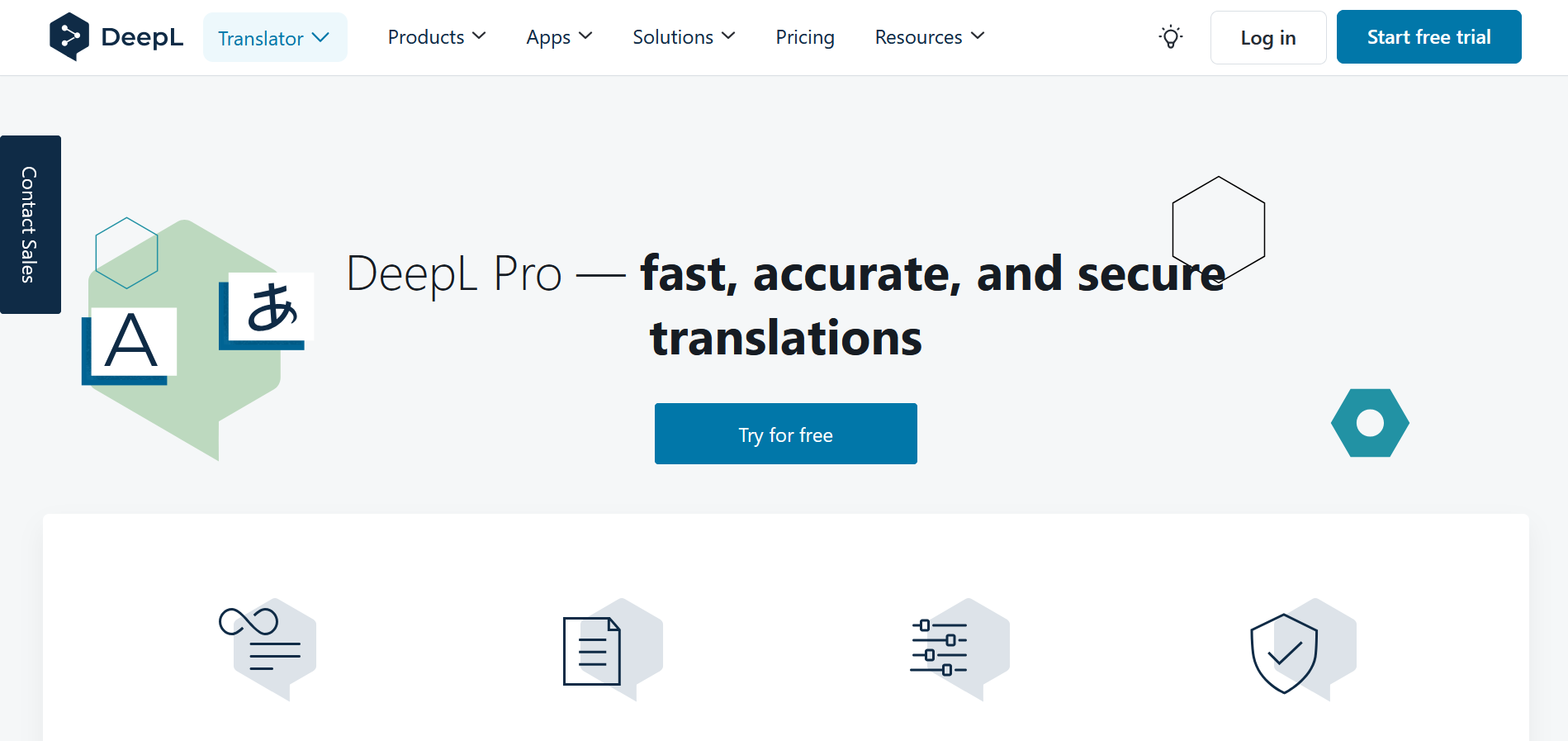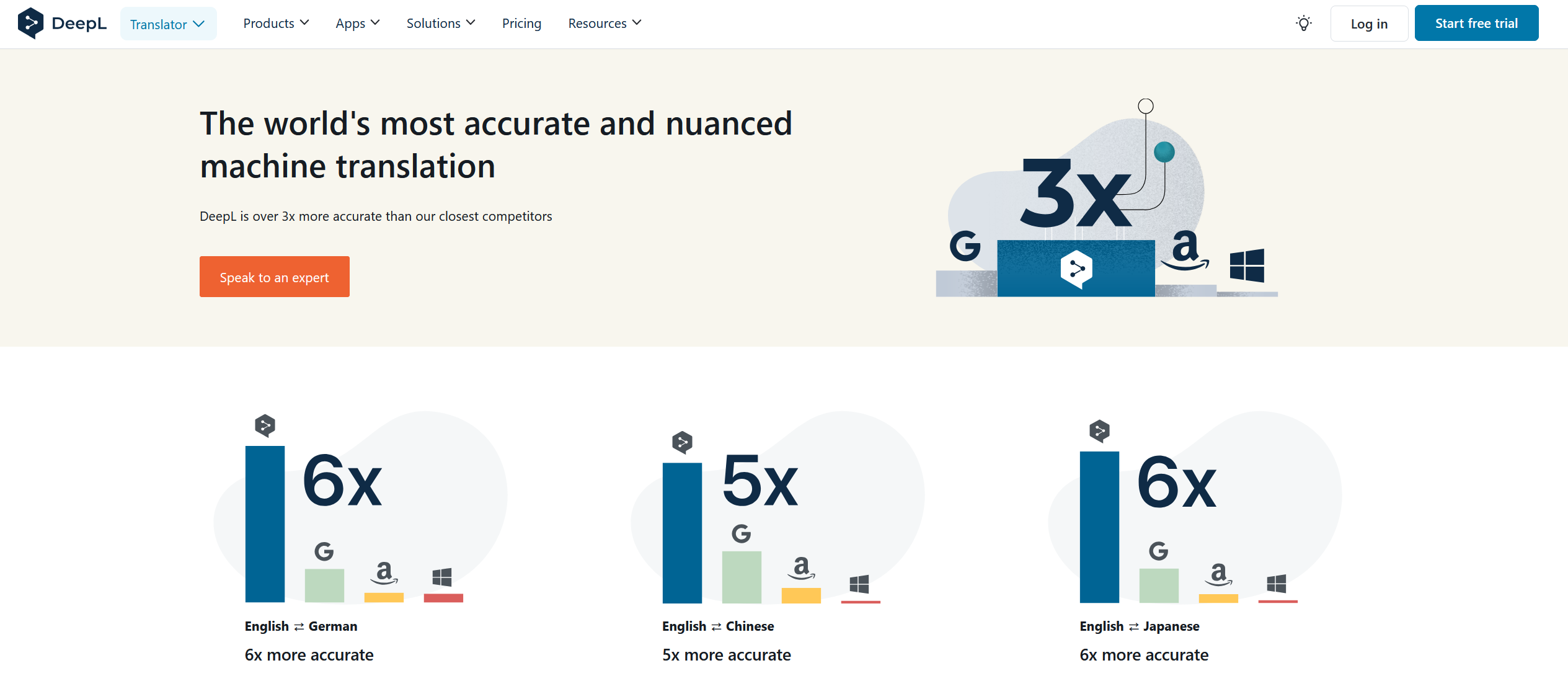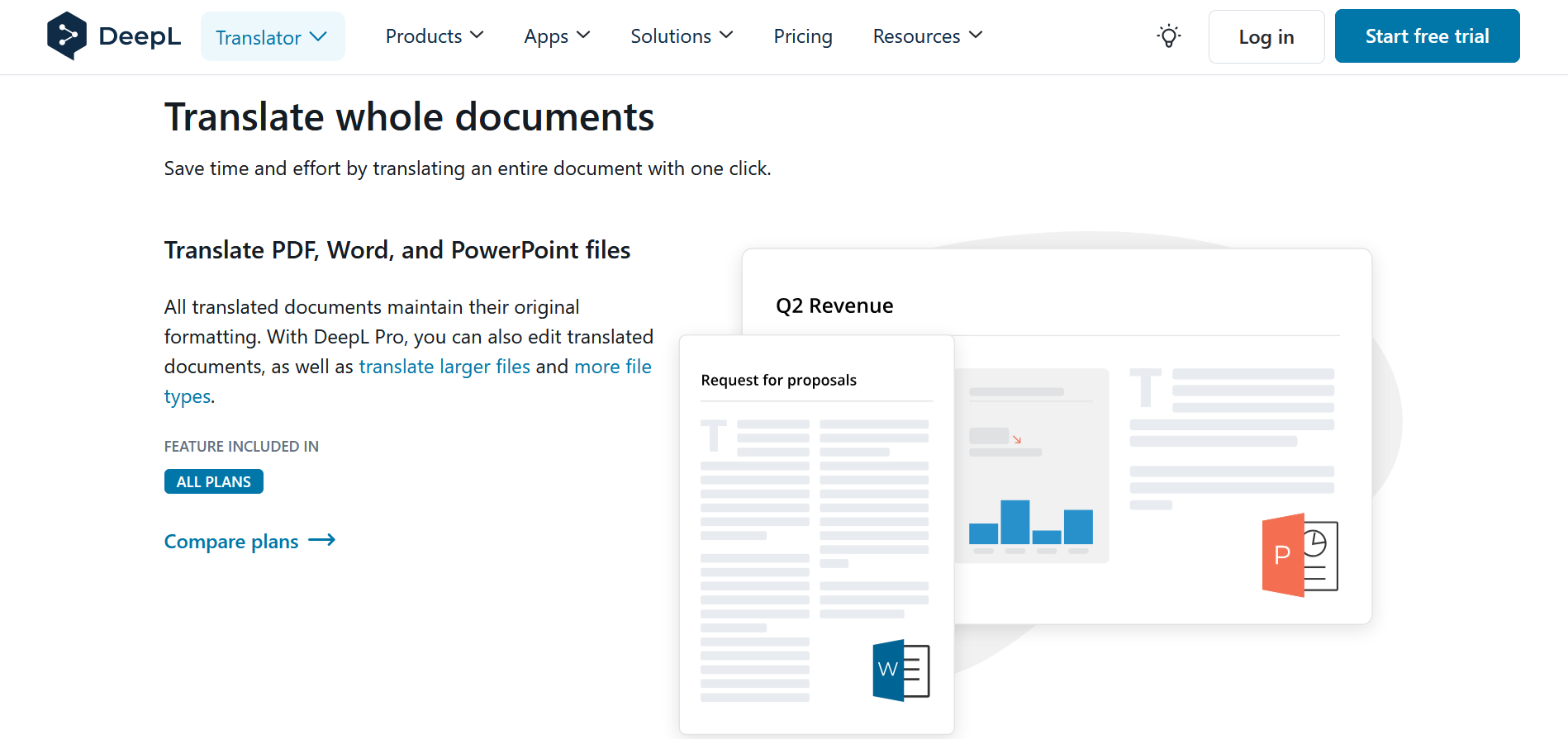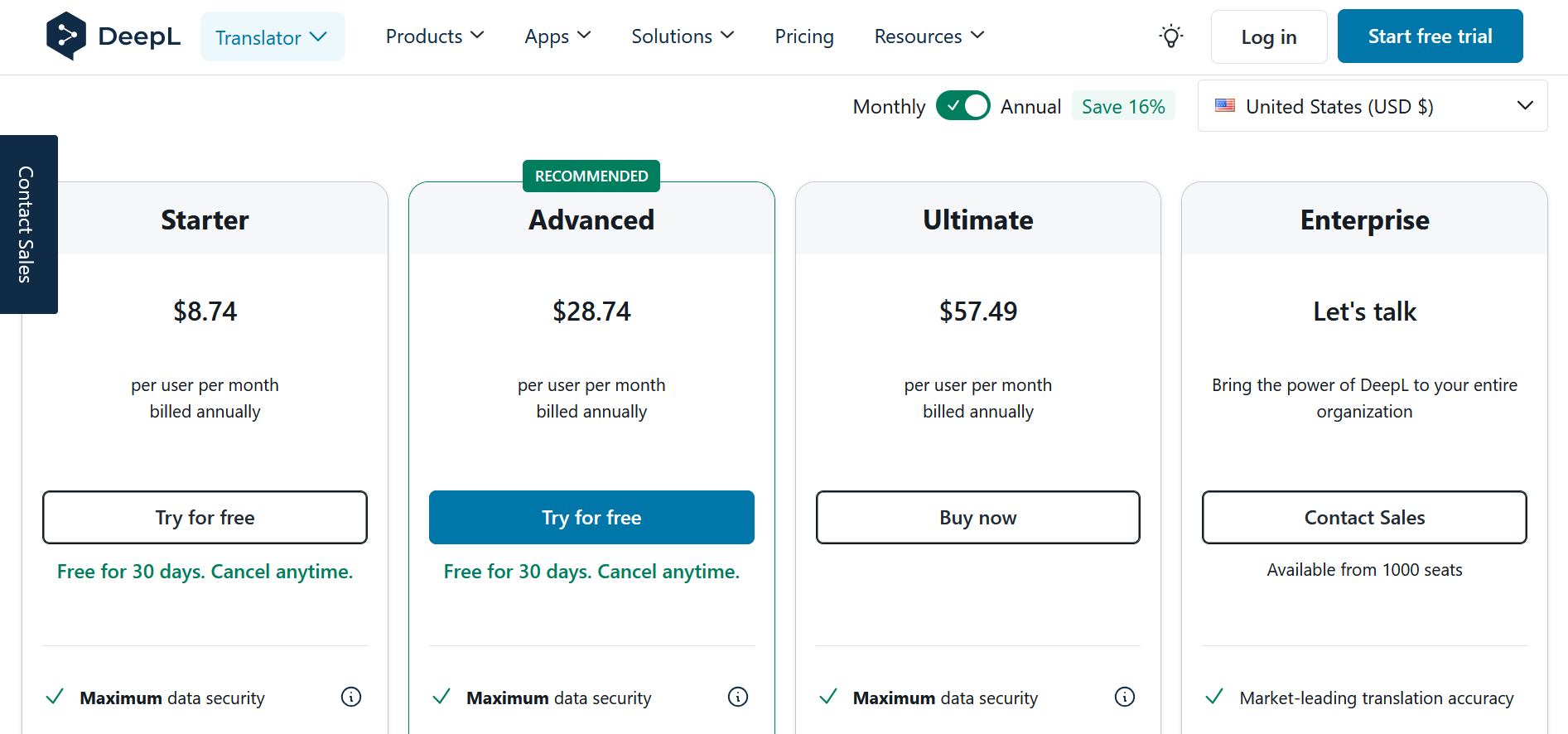In the era of globalization, online translations have become an indispensable tool for communicating and working with multilingual texts. Among the numerous translation services, the leading positions are occupied by Google Translate, Microsoft Translator, and DeepL. Their popularity is due to their advanced capabilities and the speed of query processing. Recently, the DeepL platform has attracted special attention. It is distinguished by high accuracy and naturalness of translations, which allows it to confidently compete with other market leaders. Over 10 million people use DeepL monthly. From our article, you will learn what technologies underlie it, what functions it has, where it is used, and how it differs from competitors.
Overview of DeepL
So, what is DeepL? This neural machine translation (NMT) service was launched in 2009 in Germany. Back then, it was called the “Linguee online dictionary.” Its developers managed to achieve a higher quality of translated texts than statistical machine translation (SMT) programs were able to provide at the time. The secret to their success was that they used innovative deep learning technology to train their models.

In 2017, the team created a full-fledged online translator based on Linguee, which was called DeepL Translator. At the time of release, it supported 7 languages (English, German, French, Spanish, Italian, Polish, and Dutch). As of 2024, the service translates texts between 32 languages – not only European ones but also Chinese, Arabic, Japanese, Korean, and Turkish.
In 2020 and 2021, DeepL SE developed new machine learning models that significantly improved the quality of translation. Thanks to them, DeepL began to convey the meaning of translated sentences much more accurately and even mastered professional jargon. In 2020, the online translator was awarded a Webby Award for best practices and technical achievements. In November 2022, the developers announced the DeepL Write tool for improving texts in English and German. Its public beta version appeared in January 2023.
In 2018, the company that owned DeepL SE received its first funding from the American venture investor Benchmark Capital, which acquired 13.6% of its shares. In 2023, it raised an additional 100 million euros in investment. After that, its capitalization reached 1 billion euros, making it the most valuable startup in Cologne. In May 2024, it received another 300 million euros in another investment round, led by Index Ventures. As a result, the estimated value of DeepL SE doubled. As of today, it is 2 billion euros.
Technology Behind DeepL
Since its first version, DeepL Translate has used a new technology called neural machine translation (NMT), which has replaced statistical machine translation (SMT). Until 2016, all machine translation systems worked on the basis of numerous rules added manually. This technology often translated texts literally and unnaturally, as it did not take into account the context and a number of other factors.
DeepL was one of the first to use neural networks to translate texts, which significantly increased its accuracy and other parameters. The neural network at the core of the platform was trained on millions of texts translated between different languages. It processes the entire sentence or phrase entered by the user, rather than individual words, using deep learning algorithms. Thanks to this, the result it produces is more reminiscent of human-processed text compared to translations from SMT systems. Moreover, the network architecture allows NMT algorithms to learn as they work, producing increasingly high-quality translations over time and adapting to new contexts.

The language model used by DeepL is based on the transformer architecture and is a modification of the latter. The service uses a patented algorithm with convolutional neural networks (CNN), which was trained using the Linguee database. Of course, for all this to function properly, serious equipment is needed. DeepL has a 5.1 petaflops supercomputer powered by hydroelectric power in Iceland.
To evaluate the texts translated by the system, the developers came up with a data collection mechanism. Special scanners automatically find translations on the Internet and evaluate them according to a number of criteria. In addition, the neural network is capable of self-training. It regularly compares its own results with the data loaded into it and corrects them if there are discrepancies.
And yet, is DeepL accurate? As of today, machine translation accuracy assessments are still highly subjective. Results vary depending on the language pairs selected, the topic, and user settings. Overall, the platform has a decent reputation, especially when it comes to European languages. According to user reviews, DeepL translations look more natural compared to its main competitors.
Translation Capabilities Analysis
Answering the question, how accurate is DeepL, the developers claim that it translates text three times more accurately than other popular platforms that perform machine translation. In their opinion, the NMT system is capable of recognizing and taking into account the context and the slightest semantic nuances. The team regularly checks the quality of their models using so-called “blind” tests. Professional translators evaluate the translated texts without knowing which program generated them. According to the results of the studies, DeepL surpassed its competitors by an average ratio of 3:1, and by 5:1 and 6:1 for individual language pairs.

Key functions and characteristics of the platform:
- Multilingual support. The developers are constantly expanding the list of supported languages. Users can easily and quickly switch between language pairs in a convenient interface.
- Context analysis. The language model created using AI and ML algorithms is able to recognize the context of the entered text, ensuring contextual accuracy of the translation. This allows it to translate complex sentences and idioms more efficiently.
- Selection of apps and plugins. In addition to the web version, DeepL offers apps for Android, Windows, iPhone, iPad, Mac, and Chrome OS. There are also plugins for Google Chrome, Edge, Firefox, Microsoft Word, and Google Workspace.
- AI text editor. DeepL Write's built-in text editor checks the spelling, grammar, and punctuation of texts. Moreover, it improves their style and tone by selecting alternative words and sentences.
- Translation of documents. The platform translates not only text pasted from the clipboard but also entire documents in DOCX, PDF, and PPTX formats.
- Data privacy. The company that owns the service is located in Germany and strictly adheres to EU legislation on the protection of personal data. The developers claim that the exchange of data between users and the platform takes place via an encrypted connection, and translated texts are immediately deleted from the servers.
- DeepL API. The presence of the API allows integrating DeepL tools with third-party software. This is useful for automatic website localization, multilingual support in corporate systems (Zendesk, Confluence, SharePoint), translating product descriptions, reviews, comments, and other content.
Practical Applications and Pricing
In recent years, DeepL has shifted its focus to the corporate sector. The introduction of the paid Pro version changed the company's business model. It shifted from advertising revenue to subscription revenue, purchased primarily by corporate clients. The system's most prominent users include Deutsche Bahn, Roche, Fujitsu, Axa, Best Buy, Nokia, Rakuten, Siemens, and Elsevier.

DeepL is most often used to work with the following types of content:
- Content with low visibility and traffic. This includes emails, web page footers, internal notes, social media posts for sentiment analysis, and so on.
- Medium visibility content that impacts user experience. This includes knowledge bases, FAQs, guides, tutorials, and notifications. They should be highly accurate and written in a “human” language. AI algorithms do a good job of this.
- Technical content. The service has proven itself well in translating operating instructions and other technical texts. It is advisable to send especially important content to a human specialist for verification after translation.
- User-generated content: DeepL is great for translating user-generated content: product reviews, testimonials, comments, and more.
- Product titles and descriptions. The system demonstrates high performance when it is necessary to translate a large volume of text in a short time. One example is product descriptions.
Is DeepL free? To some extent, probably yes. The basic free version allows you to translate texts up to 1,500 characters and upload up to 3 documents per month. As for the paid plans, DeepL pricing looks like this:
- Starter (unlimited translations via web version and applications; up to 5 editable file translations; file “weight” – up to 10 MB; 1 glossary with 5,000 entries) – $8.74 per month per user.
- Advanced (unlimited translations via web version and applications; up to 20 editable file translations; file “weight” – up to 20 MB; 2,000 glossaries with 5,000 entries in each) – $28.74 per month per user.
- Ultimate (enhanced data protection; unlimited translations via web version and applications; up to 100 editable file translations; file “weight” – up to 30 MB; 2,000 glossaries with 5,000 entries in each) – $57.49 per month per user.
- Enterprise (from 1,000 users) – the cost is calculated individually and is provided upon request.
The prices shown are valid for a full year of payment at once. If you pay monthly, the price will be 16% higher. A 30-day free trial is available for the Starter and Advanced plans.

There are separate rates for tool kits:
- DeepL Translator + DeepL Write – from $17.49 to $61.89 per month per user.
- DeepL API – from $0 to $5.49 per month.
DeepL vs Google Translate vs ChatGPT
Most users who need a quality translation are very interested in whether DeepL is better than Google Translate. The answer to this question largely depends on your specific goals and needs, as well as the context of the request. By common opinion, the product of the German startup makes a more accurate translation compared to the brainchild of the Californian corporation. At the same time, DeepL has a rather significant drawback: a limited number of supported languages (currently there are 32, and most of them are European). According to this criterion, it significantly lags behind Google Translate, which supports over 100 languages.
In addition, free DeepL accounts receive a very modest set of functions, which are significantly expanded only after purchasing a paid subscription. Google Translate is more convenient for users with a free account, but its translations are sometimes not as accurate. In general, both services provide effective machine translation tools. If you are interested in maximum accuracy, advanced functionality, and are ready to pay for them, choose DeepL. If simplicity and accessibility are more important to you, Google Translate will be the best solution.
As for the DeepL vs ChatGPT comparison, it is not entirely correct. The chatbot does not belong to specialized NMT systems, although it is capable of automatically translating texts between dozens of languages. It is worth noting that the quality of its translation is noticeably inferior to the result of DeepL, especially when it comes to recognizing the context, as well as words and phrases with several meanings. ChatGPT translates texts more literally and does not have a glossary. This limits its functionality in remembering the meanings of terms. As a result, you have to enter them manually through prompts, which makes using the service less fast and convenient.
Conclusion
It is obvious that the project of the startup from Germany has great prospects and may well become the number one commercial online translator in the coming years. It is based on a carefully trained and constantly improved neural network, which provides increased accuracy of translations with recognition of subtle meaning and context. Among other key advantages of DeepL, they note rich functionality with a variety of special tools for translators and quite flexible pricing. Its API and built-in AI text editor, DeepL Write, are no less useful.
However, its creators still have some work to do. First of all, on the number of supported languages. After all, in this parameter, the service is significantly inferior not only to well-known machine translation platforms but even to chatbots with AI like ChatGPT or Gemini.
